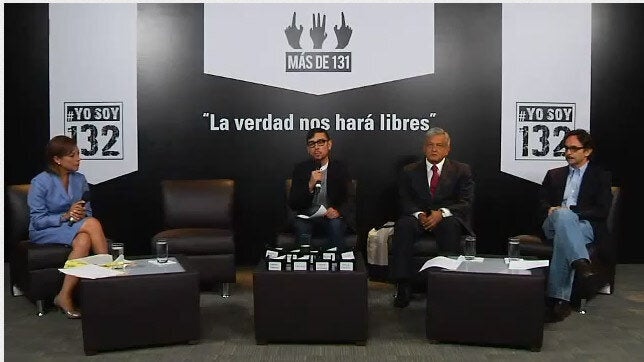
By Natalia Cote and Arturo García / MEPI
The Mexican university student movement known as #YoSoy132 hit another milestone June 19 -- it held the first student-led presidential debate. The organizers convinced three of the four candidates for president to meet for a two hour question and answer session that was televised on YouTube and carried by university radio stations and other Internet sites.
#YoSoy132 has riveted Mexico with new ideas and a fresh approach to politics -- engaging a country awash in electoral fatigue and disenchantment. Close to 200,000 viewers attempted to tune in to the YouTube channels to follow the debate. And it is estimated that several thousand more listened to it on the radio.
Citizens and Technology were winners
The debate was moderated by a journalist, an academic and a member of #YoSoy132. Each moderator led a set of questions, which were selected and approved by a throng of students and citizens who communicated with the moderators through Google Hangout and Google Moderator.
Citizen participation is often missing in Mexican politics. "Politicians are used to unilateral discussions," said Maria Elena Meneses, a professor at the Tecnologico de Monterrey and expert on media and social networks. "Since the 1990s, they have been talking to the electorate via televised spots and debates. Our politicians are afraid of facing and engaging citizens," she added.
The two previous debates held by the Instituto Federal Electoral, (IFE), which regulates electoral processes, offered candidates previous access to the issues to be debated. Thus the events were wooden and predictable. During the first debate in May, the only revelation was the presence of a scantily-clad former Playmate who served as an usher.
The youth debate has been branded as historical. "It brought young people into it, a sector that is often forgotten by politicians. It shows what a motivated and well-organized group is able to do," said Javier Garza, editor of El Siglo, a daily in the province of Torreon.
The digital divide
The only negative reactions were from critics who said the technological advances that made the broadcast groundbreaking, were also its limitations. The debate was not accessible to all Mexican voters, and most of its viewers were in major cities. Student organizers refused to allow commercial stations to broadcast the event. With this action they lost a lot of viewers. Only 3 out of ten Mexican citizens have access to Internet and social networks.
Enrique Peña Nieto, candidate for the Partido Revolucionario Institucional (PRI), which ruled Mexico for 71 years uninterrupted until the center rightist Partido Accion Nacional (PAN) won elections in 2000, refused the invitation to participate in the debate. His handlers correctly argued the debate might not be impartial. The #YoSoy132 movement is explicitly anti-Peña Nieto, a position that has gained it some criticism but a lot of support among many young voters, who are concerned that Peña Nieto will win the July 1 elections and return the PRI to power.
The three other candidates, Josefina Vázquez Mota from the PAN, Andrés Manuel López Obrador, from the left of center Partido de la Revolucion Democratica (PRD), and Gabriel Quadri de la Torre, representing the independent Partido Nueva Alianza (PANAL), all accepted the invitation to debate.
Peña Nieto was represented with an empty chair that was placed in the television set as a reminder that he had declined the invitation to participate.
Students Rule
The growth of the Mexican university movement is only five weeks old, but it has shaken political structures. Organizing the debate is only one of its victories.
As anything that is successful, there have been a few attempts to bring it down. The day before the debate, a video claiming the movement was linked to the Mexican left hit the media. The evidence presented was a surreptitiously recorded conversation between two former members, where one identified as a movement leader stated he had steered the movement towards the leftist PRD.
#YoSoy132 immediately clarified its political positions and said the group had people with various political ideologies, and that the movement has no leaders. It was later found out that the accuser was a follower of the PRI candidate.
The #YoSoy132 is a major achievement for students in Mexico. Formed and kept alive through social networks, the group has grabbed the attention of the next generation of Mexican voters, who are traditionally ignored. As Professor Meneses said, the youth in Mexico include people 18 to 34, they comprise 40 percent of all voters going to the polls next July 1.
The movement might not influence electoral results, but its emergence has brought a new meaning to politics. "Older voters should thank them for rising up," said Meneses.